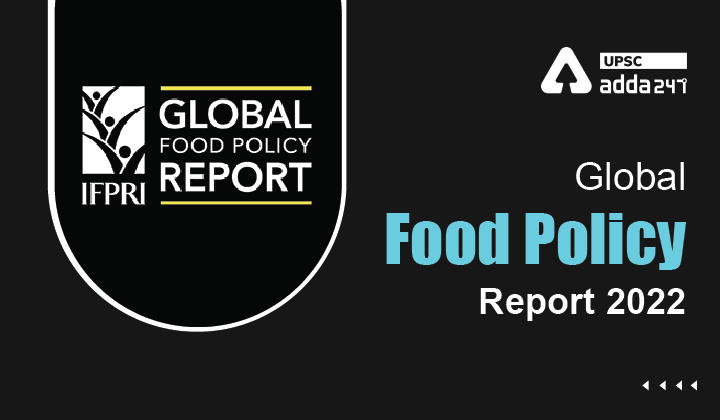Table of Contents
Global Food Policy Report UPSC: Relevance
- GS 2: Issues relating to poverty and hunger.
Global Food Policy Report IFPRI: Context
- According to the Global Food Policy Report 2022 published by the International Food Policy Research Institute (IFPRI), India’s food production could drop 16% and the number of those at risk for hunger could increase 23% by 2030 due to climate change.
Global Food Policy Report 2022: Key points
- These projections are part of a model named IMPACT, which was used to evaluate the impact of climate change on aggregate food production, food consumption (kcal per person per day), net trade of major food commodity groups, and the population at risk of going hungry.
- The model was developed with inputs from scientists from the Consortium of International Agricultural Research Centers (CGIAR) and other leading global economic modelling efforts.
- Impacts of COVID-19 and other current geopolitical factors have not yet been incorporated in these projections.
Global Food Policy Report 2022: India
- Population at risk: The number of Indians at risk from hunger in 2030 is expected to be 73.9 million in 2030.
- Additionally, if the effects of climate change were to be factored in, the vulnerable population would increase to 90.6 million.
- Positive calorie consumption: Climate change will not impact the average calorie consumption of Indians and this is projected to remain roughly the same at 2,600 kcal per capita per day by 2030 even in a climate change scenario.
Global Food Policy Report 2022: World
- Increase in food production: Global food production will grow by about 60% over 2010 levels by 2050 in the context of climate change.
- Notably, production and demand are projected to grow more rapidly in developing countries, particularly in Africa, than in developed countries, due to projected growth in population and incomes.
- Shift in dieting: Diets are also shifting toward higher-value foods, including more fruits and vegetables, processed foods, and animal-source foods, outside of high-income countries.
- Also, meat production is projected to double in South Asia and West and Central Africa by 2030 and triple by 2050.
- Despite this growth, however, per capita consumption levels in developing countries will remain less than half of those in developed countries.
- Processed foods: The demand for processed foods would also increase in the growing production of oil crops: by 2050 production is expected to more than double in Southeast Asia and West and Central Africa.
- Fruits and vegetables: Production of fruit and vegetables is projected to grow more than double in regions like Central and West Asia and North Africa; East and Southern Africa; and West and Central Africa by 2050.
- Inequitable distribution of produces: However, regional differences in access to food mean that nearly 500 million people are projected to remain at risk of going hungry.
- Globally, about 70 million more people will be at risk from hunger because of climate change, including more than 28 million in East and Southern Africa.
Global Food Policy Report 2022: Recommendations
- Investments in R&D for innovation: The report recommends doubling current levels of public funding for agricultural R&D, including $15 billion per year for innovations targeted to benefit sustainable intensification in LMICs (low- and middle-income countries).
- Improved governance of resources: Policymakers must incentivize integrated landscape management, promote the adoption of clean energy sources, work to restore soil quality, strengthen rights for land tenure, and ensure equitable access to water and other natural resources.
- Healthier diets and more sustainable production: To support healthier global diets, the report recommends all countries adopt national food-based dietary guidelines, prioritize R&D for nutrient-rich foods, and support changes in the food environment that nudge consumers toward healthy and sustainable choices.
- Stronger value chains: Recommendations include ensuring that non-discriminatory trading rules for agriculture and food are aligned with into climate-smart policies, while investing in low-emissions solutions for safe, efficient storage and transportation along value chains.
- Climate-smart finance: Repurposing government support to agricultural sectors provides a major opportunity to do away with harmful subsidies and border measures, reorient finance towards R&D in green innovations.
Read current affairs for UPSC





 TSPSC Group 1 Question Paper 2024, Downl...
TSPSC Group 1 Question Paper 2024, Downl...
 TSPSC Group 1 Answer key 2024 Out, Downl...
TSPSC Group 1 Answer key 2024 Out, Downl...
 UPSC Prelims 2024 Question Paper, Downlo...
UPSC Prelims 2024 Question Paper, Downlo...
